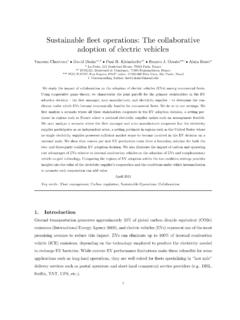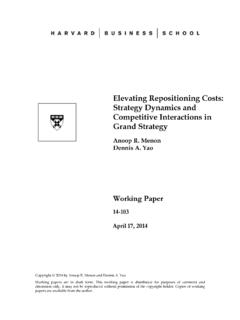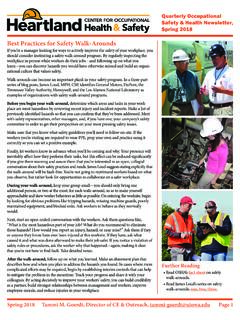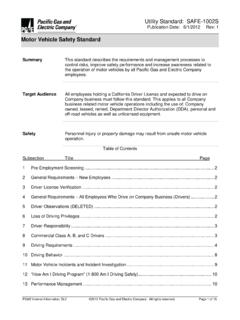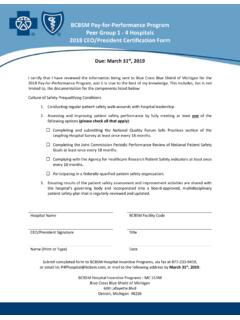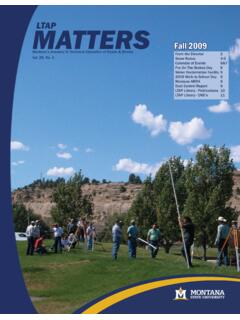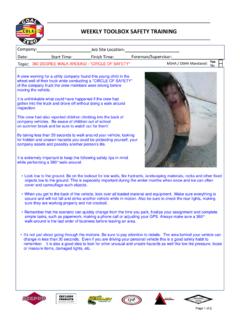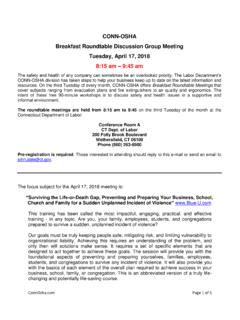Transcription of The Effectiveness of Management-By-Walking- Around: A ...
1 Copyright 2012, 2013 by Anita L. Tucker and Sara J. Singer Working papers are in draft form. This working paper is distributed for purposes of comment and discussion only. It may not be reproduced without permission of the copyright holder. Copies of working papers are available from the author. The Effectiveness of Management-By-Walking- Around: A Randomized Field Study Anita L. Tucker Sara J. Singer Working Paper 12-113 September 4, 2013 The Effectiveness of Management-By-Walking- Around: A Randomized Field Study Anita L. Tucker, Harvard Business School Sara J.
2 Singer, Harvard School of Public Health September 4, 2013 Abstract Management-By-Walking- Around (MBWA) is a widely adopted technique in hospitals that involves senior managers directly observing frontline work. However, few studies have rigorously examined its impact on organizational outcomes. This paper examines an improvement program based on MBWA in which senior managers observe frontline employees, solicit ideas about improvement opportunities, and work with staff to resolve the issues. We randomly selected 19 hospitals to implement the 18-month long MBWA-based improvement program; 56 work areas participated.
3 We find that the program, on average, had a negative impact on performance. To explain this surprising finding, we use mixed methods to examine the impact of the work area s problem solving approach. Results suggest that prioritizing easy-to-solve problems was associated with improved performance. We believe this was because it resulted in greater action taking. A different approach was characterized by prioritizing high value problems, which was not successful in our study. We also find that assigning to senior managers responsibility for ensuring that identified problems get resolved resulted in better performance.
4 Overall, our study suggests that senior managers physical presence on their organizations frontlines was not helpful unless it enabled active problem solving. Funding provided by Agency for Healthcare Research and Quality RO1 HSO13920. Additional funding from Fishman Davidson Center at Wharton. 1 1. Introduction Hospitals face an imperative to improve quality of care and decrease medical errors that harm patients. Healthcare thought leaders and policy makers have advocated for the adoption of Management-By-Walking- Around (MBWA) to achieve these goals, resulting in widespread adoption in the and the (Institute for Healthcare Improvement 2004, National Patient safety Agency 2011).
5 These types of programs in which senior managers visit the frontlines to work with staff to identify and resolve obstacles came to the attention of hospitals with the publication of one healthcare system s success at improving safety climate through its MBWA-based intervention (Frankel et al. 2003). Despite the intuitive appeal of MBWA, evidence on the program s efficacy is mixed. Of seven hospitals that implemented an MBWA-based program, only two sustained the effort over a three-year period (Frankel et al. 2008). Those two reported a positive impact on staff perceptions of safety climate, but the effect on the five aborting hospitals was not reported.
6 A study of one Veterans Affairs hospital found that patient safety climate worsened on two units that implemented the program, while it improved or stayed the same on two control units that did not implement the program (Singer et al. 2013). Another found that hospitals that implemented a general improvement program with an MBWA component did not improve on a variety of measures compared to control hospitals (Benning et al. 2011). To test more systematically the impact of MBWA-based improvement programs, we implemented one such program in 19 randomly selected hospitals. We compared nurses perceptions of improvement in performance in work areas that implemented the program to the same type of areas at 68 randomly selected control hospitals that did not implement the program.
7 Our study thus sheds insight into the program s generalizability beyond those where senior managers decided on their own to implement such a program. We find that, on average, our MBWA-based program had a negative impact on nurse perceptions of performance, suggesting that 2 senior manager presence on hospital frontlines to solicit improvement ideas could be detrimental to workers perceptions. However, we find that our MBWA-based program was associated with improved perceptions of performance under two conditions: (1) when a higher percentage of solved problems were considered easy to solve, enabling more problem solving, and (2) when senior managers took responsibility for ensuring that identified problems were resolved.
8 This suggests that the action-taking that results from the program, rather than the mere physical presence of the senior managers, is what positively impacts the front line staff. 2. MBWA-based Improvement Program s Impact on Performance Research has found that quality improvement programs that solicit frontline workers ideas, such as MBWA, can have a beneficial impact on organizational outcomes (Dow et al. 1999, Powell 1995). MBWA relies on managers to make frequent, learning-oriented visits to their organization s frontlines to observe work and solicit employees opinions (Packard 1995).
9 Hewlett-Packard, the company in which MBWA originated, attributed its success using MBWA to good listening skills, willing participation, a belief that every job is important and every employee is trustworthy, and a culture where employees felt comfortable raising concerns (Packard 1995). MBWA is similar to the Toyota Production System s gemba walks (Mann 2009, Toussaint et al. 2010, Womack 2011). In a gemba walk, managers go to the location where work is performed, observe the process, and to talk with the employees (Mann 2009). The purpose is to see problems in context, which aids problem solution (Mann 2009, Toussaint et al.)
10 2010, Womack 2011). MBWA has resulted in positive organizational change (Frankel et al. 2003, Pronovost et al. 2004). One explanation is that MBWA leads to successful problem resolution because seeing a problem in context improves managers understanding of the problem, its negative impact, and its causes; increasing their motivation and ability to work with frontline staff and managers to resolve the issue (Mann 2009, Toussaint et al. 2010, von Hippel 1994, Womack 2011). Theory further 3 suggests that MBWA s repeated cycles of identifying and resolving problems may create an organizational capability for improvement that reduces the cost of future improvement efforts, creating a positive dynamic (Fine 1986, Fine and Porteus 1989, Ittner et al.
